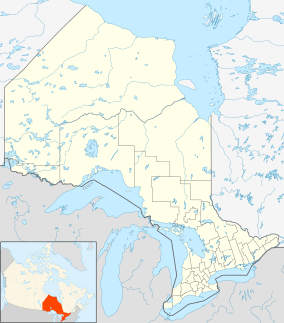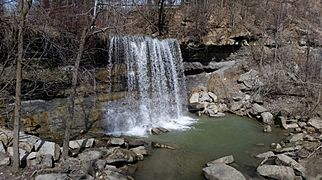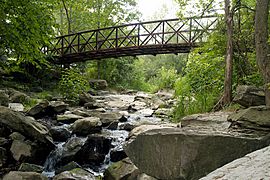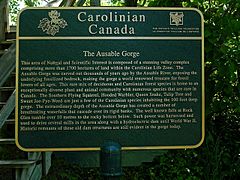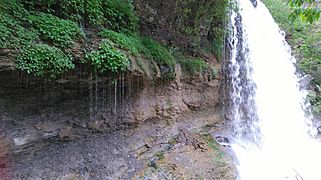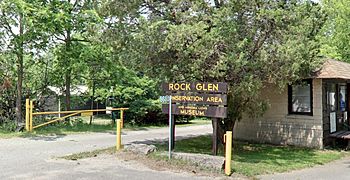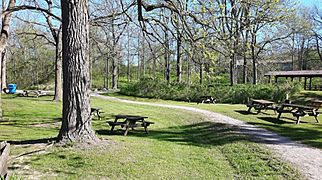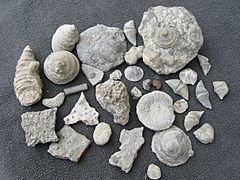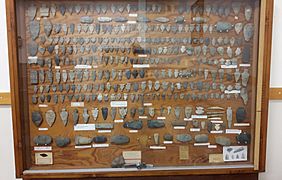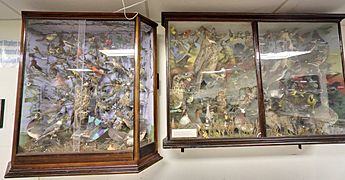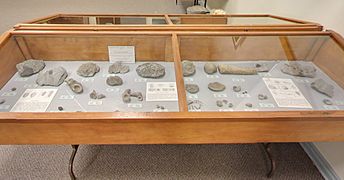Rock Glen Conservation Area facts for kids
Quick facts for kids Rock NameConservation Area |
|
|---|---|

Rock Glen Conservation Area (Arkona, Ontario, Canada).
|
|
| Location | Arkona, Ontario, Lambton Shores, Ontario, Canada |
| Area | 27 ha (67 acres) |
| Elevation | 181 m (594 ft) |
| Established | 2011 |
| Named for | Former Rock Glen Power Company, 1907. |
| Governing body | Ausable Bayfield Conservation Authority |
Rock Glen Conservation Area is a special natural place in Arkona, Ontario, Canada. It is like a protected park where nature is kept safe. The Ausable Bayfield Conservation Authority (ABCA) takes care of this area. They work to protect local plants and animals. They also help manage floods and keep the environment healthy.
Rock Glen is in a unique spot. It sits between two different forest types. To the south is the Carolinian forest zone. To the north is the Great Lakes (St. Lawrence Zone). This mix means you can find many different kinds of plants and animals here. The area also has a museum called the Arkona Lions Museum and Information Centre. It shows cool fossils and old tools from early peoples.
Exploring Rock Glen's Past
Ancient Peoples and Their Tools
People have lived around Rock Glen for a very long time. About 10,000 years ago, early First Nations hunted caribou here. Later, about 6,000 years ago, other groups adapted to a warmer climate. The museum at Rock Glen shows amazing tools from these early peoples. You can see "fluted points" and "Clovis Point Meadow Cache Blades." These tools tell us about their lives long ago.
Fossils from an Ancient Sea
Rock Glen is famous for its incredible Devonian Period fossils. These fossils are about 350 million years old! Back then, this area was covered by a warm, shallow sea. Water has slowly worn away the land, showing these ancient treasures. This special area is called the "Hungry Hollow Formation."
The most common fossils you can find are brachiopods, which look like seashells. You might also see horn corals and parts of crinoids. Crinoids are often called "sea lilies" because they look like plants. Sometimes, lucky visitors even find trilobites. These are ancient sea creatures that look a bit like insects.
Mills, Dams, and Waterfalls
In the mid-1800s, pioneer settlers came to this area. They built grist mills to grind grain. One mill used a huge 11-meter water wheel. You can still see where the mill pond was, near the beautiful Rock Glen Falls. There is even a platform where you can get a great view of the waterfall.
Later, in 1907, a company built a small dam on the Ausable River. It made electricity for a short time. After World War II, the dam was no longer used. To help fish swim upstream, the dam was blown up with dynamite. You can still see parts of the old dam in the river.
- Photo Gallery of Rock Glen Conservation Area
Plants and Animals of Rock Glen
Diverse Trees and Wildflowers
Rock Glen is home to many different plants and animals. This is because it is a "transition zone" between two forest types. You can find trees like sugar maple, beech, and white elm. Other native trees include sycamore, sassafras, and black walnut. There are also many types of oak, ash, and pine trees.
If you visit in the spring, you will see over 50 types of wildflowers. They add beautiful colors to the forest floor.
Wildlife You Might See
Small mammals and many songbirds live here. You might spot an eastern coyote or a deer. Look for muskrat near the water. You may also see a common garter snake sunning itself.
Birds of Rock Glen
Many different bird species visit or live in Rock Glen. Here are some you might see or hear:
- Eastern meadowlark
- Red-winged blackbird
- Bobolink
- American woodcock
- Savannah sparrow
- Rose-breasted grosbeak
- Pileated woodpecker
- Red-eyed vireo
- Blue jay
- American robin
- Great-crested flycatcher
- Hairy woodpecker
- Scarlet tanager
- Northern oriole
- Eastern kingbird
- Field sparrow
- House wren
- Yellow shafted flicker
- Indigo bunting
- Grey catbird
- Brown thrasher
Fun Things to Do at Rock Glen
Arkona Lions Museum and Information Centre
The Arkona Lions Museum and Information Centre is a great place to start your visit. It has a large collection of preserved birds and wildlife. The museum also shows many fossils and old tools found nearby. You can learn a lot from their presentations and guided tours. These tours are great for families and school groups.
Exploring the Glen and Waterfalls
Rock Glen has many stairs, boardwalks, and bridges. These help you safely explore the steep sides of the glen. You can walk along trails that lead to the 10.7-meter high waterfall. This waterfall is just upstream from the Ausable River.
Fossil Hunting and Hiking Trails
The exposed rock beds at Rock Glen are full of fossils from 350 million years ago. You might find crinoids, brachiopods, or even trilobites. The park allows visitors to take one fossil if you find it on the surface without digging.
There are also public washrooms and two picnic pavilions. You can reserve a pavilion for a party or gathering. Near the pavilions, you will find playground equipment. There are many trails for hiking and lookouts with amazing views. Rock Glen Conservation Area also offers special guided and educational hikes for groups and schools.
- Arkona Lions Museum and Information Centre


